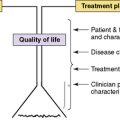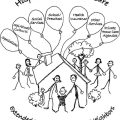21 Introducing Home-Based Palliative Care and Hospice
The majority of children who die in the United States do not die at home. Nearly three-fourths of pediatric deaths occur in the hospital, mostly in intensive care units (ICUs) where aggressive, life-sustaining medical therapy is typically provided.1 Home-based palliative care and hospice programs serve less than a third of the children who die, and the majority of those hospice agencies do not have specially trained pediatric teams. Even when this specialized service is available in the community, it is often underused.
The number of children who die at home as a result of complex chronic conditions has been steadily increasing during the last twenty years. The growing number of these children has been cited as a justification to expand the capacity for home-based hospice and home-nursing care in order to meet the increasing palliative care needs of these complicated pediatric patients.2
In 2008, the availability of home-based hospice care was demonstrated to have an indirect positive effect on the quality of end-of-life experience and bereavement. The study showed that families of children with severe life-limiting illnesses who have home care available are five times more likely to participate in the planning of their child’s location of death. The opportunity to plan was associated with better experiences at the end of life and less prolonged grief afterward.3
Recognizing the Barriers to Palliative Care
Constraints within our medical culture include limited financial resources for specialized pediatric palliative care, limited access in rural regions, lack of research and evidence-based guidelines, and lack of provider training and expertise. These barriers are best addressed at the level of resource allocation, policy, local and governmental advocacy, and curriculum development.4 There has been a gratifying, if small, increase in the awareness of these issues in the last decade but clearly the gains accomplished so far have only advanced the frequency of referrals by a small amount.
The barriers to palliative care and hospice referral that are related to clinical practice are more subtle. In 2008, Davies and colleagues identified 26 barriers to palliative care referral within a large pediatric teaching hospital. The five most frequently cited barriers from the providers’ perspective were uncertainty of prognosis, families not being ready to acknowledge the incurable condition, language barriers, time constraints, and families’ preferences for life-sustaining care.1
Uncertainty of prognosis is much more common in pediatric patients than in adults. In most pediatric palliative care programs, cancer represents less than half of all diagnostic groups. Children with chronic and complex life-limiting conditions now represent a wide variety of illnesses, including those caused by prematurity, congenital disorders of every organ system, neurodegenerative abnormalities, and malignancies. All of these disorders are relatively rare and often do not lend themselves to accurate predictions about either the response to treatment or the likelihood of survival. This uncertainty can lead to confusion that undermines the goals of care and leads to a “dichotomous cure vs. palliative care” approach.1 In this framework neither parents nor medical teams are willing to pursue palliative care or hospice until all are sure that no curative option exists. Thus referral occurs inevitably late when the opportunity to plan and arrange for quality care at the end of life may no longer be possible. Uncertainty also has the ability to undermine the medical team’s credibility with families who expect expert medical personnel to be able to predict the natural history of their child’s disease. Uncertainty over prognosis in this situation can erode the family’s trust, it can impede the development of consensus for care, and delay spiritual and psychosocial support, all of which may contribute to increased suffering.
The death of a child is never within the natural order of things and is therefore “always out of season.”5 It is not surprising then that the second- and fifth-most common barriers to referral are the families’ lack of readiness to acknowledge an incurable condition and families’ preference for life-sustaining treatment. There is considerable overlap among these barriers. Families are often confronted with unexpected reversals, idiosyncratic responses to therapy and plateaus of relative stability that inspire them to hope for a positive resolution of their child’s disease. Their best hopes for recovery are often supported by the promises of the latest treatment and the newest technology or by the recounting of miraculous recoveries promoted by the media and the hospital’s own marketing department. At times, some members of the clinical care team are unable to stop aggressive medical treatment, even while they are discussing end-of-life options, because they cannot know with absolute certainty that a child will die. This mixed message adds to the family’s uncertainty. The medical team often recognizes a terminal prognosis before families do.6 Bridging the gap between the team’s and the family’s understanding of the child’s terminal diagnosis is difficult. If done too abruptly it can create tension between the staff and family; if it is delayed and aggressive curative care is continued beyond the limits of perceived benefit, then both the staff and the family can suffer acute moral distress.7 There is growing evidence that the introduction of skilled communicators at this point may facilitate clearer understanding of the prognosis and promote a unified approach to goals of care.
The increasingly technological sophistication of diagnostic and treatment procedures and the sensitive nature of end-of-life communication challenges the assurance that the family’s understanding is adequate to meet the minimum requirements of informed consent. This challenge is increased when families have limited proficiency in English. U.S. federal antidiscrimination laws require that healthcare facilities receiving federal funds provide professional interpreter services for families with limited English proficiency, but the mandate is seldom enforced. The cultural barriers extend beyond language. For example, many Latino families view the physician as a figure of authority and consider it impolite to question, correct, or disagree. Some promising innovations include states that have adopted Medicaid codes that include compensation for medical translation and health organizations that have diversity centers which employ cultural navigators for families.8
Forgoing the Search for the Dying Point
The majority of medical providers view home-based palliative care and hospice as a changed dimension of care instituted once it is agreed that death is the likely outcome for the patient.9 Conflict from many sources occurs when the provision of palliative care or hospice is viewed as a new approach to care distinct from aggressive medical management. Because providers view palliative care as a distinctly different model of care, they are tempted to search for the point along the illness trajectory when they are sure death is inevitable, the dying point, and then transition to palliative care or hospice. This approach is not helpful because there is rarely agreement about the timing of the dying point.6 Empirical attempts to predict which children will need palliative care when it is tied to the timing of death have been unproductive.10,11
Adopting such a model of palliative care and hospice as timely and coincident treatment requires a shift in the attitudes of many of the acute care services. New educational programs are helping to promote this model of palliative care. Recently some programs have reported success with prospective agreements on referral criteria that automatically trigger referrals to palliative care and hospice. By doing so, these agreements obviate the search for the dying point and ensure that, at a minimum, the hospice and palliative care services have the chance to assess families’ needs in a timely manner.12 More progress will likely come by sharing the emerging evidence about the benefits of palliative care and hospice as early intervention with acute care providers. Eventually these interventions may help to create an environment where the introduction of home-based palliative care and hospice is less abrupt, more readily accepted by families and associated with better quality of life outcomes at the end of life.12
Avoiding Abandonment
Perhaps the area where adult and pediatric care differ the most is the transition process. Adults with severe life-limiting illnesses are frequently transferred to a new caregiver team for home-based hospice, with progressively limited contact from the acute service. A 2000 study suggests that adults tolerate this transfer from one team to another fairly well.13 The nature of pediatrics, the special place that the ill child occupies in the clinical milieu, and the needs of young families make the traditional model of transfer ineffective for children.
Although continuity of care has been a focus on neonatal and pediatric units for more than a decade, it is easy to see how this critical attribute is degraded when an acute care team terminates their relationship with the family and the home based palliative care team or hospice assumes a management role. Patients and their families form strong, healthy relationships with their acute providers. Nurses particularly form very strong attachments to their patients and have intimate knowledge of families’ needs and strengths.9 An abrupt transfer to a new team, regardless of the skills of its members and the best intentions of all those involved, has a profound and usually negative impact on the continuity of care that the child and the family need.14 At its worst, the transition takes on the quality of abandonment.
Maintaining Hope
Hope is not a singular entity that can be created or destroyed by circumstances or conversations. It is an essential component of the human spirit and a way of living in the world. Truthful disclosure about life-limiting pediatric disease, even when the prognosis is poor or uncertain, does not have the power to diminish hope.15 Truth telling and compassionate listening build rapport that enables hope to flourish, regardless of the circumstances. Realistic perceptions of prognosis, sensitively communicated, have the potential to transform hope into meaningful goals for children and their families, even at the end of life. An experienced clinician might explain that there are no more curative options by first reviewing all the treatment that has taken place thus far and then following with a statement such as: “If we could find another treatment that would cure this disease, we would offer it to your child, but we have tried everything and have exhausted all of our options. At this point a cure would be a miracle. We want you to know that we will continue to care for your child, and work to meet her needs, regardless of the outcome. And as we do, we will join you in hoping for a miracle.”
Compassionate relationships are the vehicles that impart hope, regardless of the trajectory of illness.15 Eliciting and establishing goals of care is essential throughout the course of treatment and has the ability to promote and transform hope. Evaluating where the family may be on the continuum of hope at any moment is a necessary starting point for conversations that build relationships. These conversations should include the sharing of specific recommendations that invite further conversation, the introduction of the possibility of death when appropriate, and the elicitation of goals of care as they continue to change. Continuity of care is central in the promotion of hope. Families and providers both benefit from maintaining the relationship with their acute care providers, even after the majority of the curative treatment has concluded.
Families value honest and complete information. The relationships that foster their hope require ready access to trusted staff. Relieving some of the burdens of care with the provision of care coordination can provide relief that allows families the emotional space to grow in hope. Hope can be supported by appropriate and honest emotional expression on the part of staff members. Parents’ hopes are supported by continuing efforts that maintain the integrity of the parent-child relationship. Religious faith can be very meaningful to families as they approach their child’s life-limiting illness. Creating a culture of acceptance and integration of spiritual belief may be crucial for some families in the promotion of hope throughout the course of the illness.16
Families’ beliefs and experiences inform their hopes. It can sometimes be helpful to families if clinicians help them to locate their hope when it appears to be elusive. An example of this might include asking the family what they hope for. When the answer they provide is “We are hoping for a cure,” then a helpful response might be “I am hoping for a cure, too. And I hope we get one, but if we are not able to have a complete remission, what else do you hope for?” Frequently families will respond with a more proximate hope, such as “I hope she will live until Thanksgiving.” By locating the nature of their deepest hopes, families can direct the goals of care in a constructive direction. The child’s care can proceed with realistic hopes without sacrificing hope at a higher level.17,18
Hope can extend into bereavement by affirming a lifelong bond with the child that continues after death. Bereaved parents strive to find ways of sustaining that lifelong bond.19 Hope can continue by sustaining belief in the possibility of making meaning out of their child’s death. Home-based programs that include bereavement, sibling programs, and ongoing support groups can assist families as they search for meaning in their child’s death and grow in the relationship with their child after death.20 Families hope to sustain life and the physical and emotional union of relationship throughout their child’s illness. That same hope can continue into bereavement as parents nurture and create lifelong bonds with their deceased children.
1 Davies B., Sehring S.A., Partridge J.C., Cooper B.A., Hughes A., Philip J.C., Amidid-Nouri A., Kramer R.F. Barriers to palliative care for children: perceptions of pediatric health care providers. Pediatrics. 2008;121(2):282-288.
2 Feudtner C., Fienstein J., Satchell M., Zhao H., Kang T. Shifting place of death among children with complex chronic conditions in the United States, 1989–2003. JAMA. 2007;297(24):2725-2732.
3 Dussel V., Kreicsbergs U., Hilden J., Watterston J., Moore C., Turner B.G., Weeks J., Wolfe J. Looking beyond where children die: determinants and effects of planning a child’s location of death. J Pain Symptom Manage. 2008;37(1):33-43.
4 Himelstein B., Hilden J.M., Boldt A.M., Weissman D. Pediatric palliative care. N Engl J Med. 2004;350(7):1752-1762.
5 Hinds P.S., Schum L., Baker J.N., Wolfe J. Key factors affecting dying children and their families. J Palliat Med. 2005;8(Suppl 1):S70-S78.
6 Wolfe J., Klar N., Grier H., Duncan J., Salem-Schatz S., Emanuel E., Weeks J.C. Understanding of prognosis among parents of children who died of cancer: impact on treatment goals and integration of palliative care. JAMA. 2000;284(19):2469-2475.
7 Elpern E.H., Covert B., Kleinpell R. Moral distress of staff nurses in a medical intensive care unit. Am J Crit Care. 2005;14(6):523-530.
8 Hunt L.M., de Voogd K.B. Are good intentions good enough? Informed consent without trained interpreters. J Gen Intern Med. 2006;22(5):598-605.
9 Docherty D.L., Miles M.S., Brandon D. Searching for the “dying point:” providers’ experiences with palliative care and acute care. Pediatr Nurs. 2007;33(4):335-341.
10 Feudtner C., Connor S.R. Epidemiology and health services research. In: Carter B.S., Levetown M., editors. Palliative care for infants, children and adolescents. Baltimore: Johns Hopkins Press; 2002:3-22.
11 Sahler O.J., Frager G., Levetown M., Cohn F., Lipson M. Medical education about end of life care in the pediatric setting: principles, challenges and opportunities. Pediatrics. 2000;105(4):575-584.
12 Hays R.M., Valentine J., Haynes G., et al. The Seattle pediatric palliative care project: effects on family satisfaction and health-related quality of life. J Palliat Med. 2006;9(3):716-728.
13 Steinhauser K.E., Christakis N.A., Clipp E.C., McNeilly M., McIntyre L., Tulsky J. Factors considered important at the end of life by patients, family and physicians, and other care providers. JAMA. 2000;284(10):2476-2482.
14 Bak A.L., Young J.P., McCown E., Engelberg R.A., Vig E.K., Reinke L.F., Wenrich M.D., McGrath B.B., Curtis J.R. Abandonment at the end of life from patient, caregiver, nurse and physician perspectives. Arch Intern Med. 2009;169(5):474-479.
15 Mack J., Wolf J., et al. Hope and prognostic disclosure. J Clin Oncol. 2007;25(35):5636-5642.
16 Meyer E., Ritholz M., Burns J., Truog R. Improving the quality of end-of-life care in the pediatric intensive care unit: parents’ priorities and recommendations. Pediatrics. 2006;117(3):649-657.
17 Feudtner C. Hope and the prospects of healing at the end of life. J Altern Complement Med. 2005;11(1):S23-S30.
18 Feudtner C., et al. Hopeful thinking and level of comfort regarding providing pediatric palliative care: a survey of hospital nurses. Pediatrics. 2007;119(1):186-192.
19 Finkbeiner A. After the death of a child: living with loss through the years. Baltimore: Johns Hopkins, 1996.
20 Murphy S., Johnson C. Finding meaning in a child’s violent death: a five-year prospective analysis of parents’ personal narratives and empirical data. Death Stud. 2003;27(5):381.






